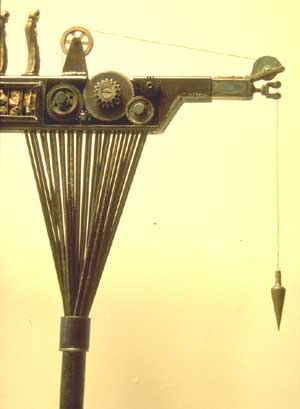
While all of this may appear to be a vision of doom and gloom, for me it is really a celebration of life.
After many years trapped in the prison of gainful employment,
like the miserable souls crammed into the holy arch along with the means of production that they do not own,
I was rendered unemployed.
This gave me the time and opportunity to focus on what I really wanted to do.
It made me more aware of how precious our brief period of physical existence really is.
In this context, the gears represent elements of a clock mechanism.
The plumb bob functions as an elegant weight, driving the clock that measures this precious time,
which is frozen here in this sculptural snapshot.
Nevertheless, time moves on, limiting what we can make of our lives.
The posts that hold up the lintel are designed to resemble a pencil and paintbrush,
as art is a basic foundation of humanity and civilization. |